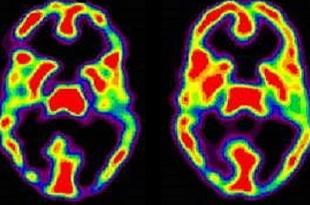Reduced Brain Connections Seen in People with Generalized Anxiety Disorder
Anxiety disorders are the most common class of mental disorders. Generalized Anxiety Disorder (GAD), which affects nearly six percent of the population, is characterized by excessive, uncontrollable worry which is persistent and very difficult to get rid of without treatment.
Dr. Jack Nitschke, associate professor of psychiatry in the UW School of Medicine and Public Health, reports new evidence which supports the theory that GAD is caused by reduced communications between different parts of the brain, specifically the amygdala, which is responsible for our "fight or flight" feelings, and the anterior cingulate cortex (ACC), the part of the brain that controls emotional response. This suggests that the brain's "anxiety button" may be stay on due to a lack of regulation of the amygdala by the ACC.
This would explain why people with GAD feel "out of control" when experiencing anxiety, while those without it may have certain times if high anxiety, but it is a fleeting moment, because they are able to "emotionally regulate" their amygdalas and calm down much faster.
The researchers did two types of imaging -- diffusion tensor imaging (DTI) and functional magnetic resonance (fMRI) -- on the brains of 49 GAD patients and 39 healthy volunteers. Compared with the healthy volunteers, the imaging showed the brains of people with GAD had reduced connections between the anterior cingulate cortex and the amygdala via the uncinate fasciculus, a primary tract that connects these brain regions. Furthermore, this reduced connectivity was not found in other tracts elsewhere in their brains.
"We know that in the brain, if you use a circuit you build it up, the way you build muscle by exercise,'' says Nitschke, a clinical psychologist who treats patients with anxiety disorders and does research at the UW-Madison's Waisman Center.
From hundreds of scientific studies, we know that cognitive behavioral therapy has the potential to decrease the amount of anxiety experienced by those with GAD, and this could explain the mechanism, in part, of how that is done. It suggests that behavioral therapy that teaches patients to consciously exercise this emotional regulation, and identify when their emotions start to go "haywire," could work to reduce anxiety by strengthening the connections between these two brain regions.
By making patients conscious of their emotional responses to events, and allowing them to realize that they have control of their response, which is done in cognitive behavioral therapy, it is possible that we are strengthening the brain connections between the amygdala and the ACC.
"It's possible that this is exactly what we're doing when we teach patients to regulate their reactions to the negative events that come up in everyone's lives,'' Nitschke says. "We can help build people's tolerance to uncontrollable future events by teaching them to regulate their emotions to the uncertainty that surrounds those events.”
Published 4/19/2013
Our History and Our Mission
The Anxiety Network began in 1995 due to growing demand from people around the world wanting help in understanding and overcoming their anxiety disorder. The Anxiety Clinic of Arizona and its website, The Anxiety Network, received so much traffic and requests for help that we found ourselves spending much of our time in international communication and outreach. Our in-person anxiety clinic has grown tremendously, and our principal internet tool, The Anxiety Network, has been re-written and re-designed with focus on the three major anxiety disorders: panic, social anxiety, and generalized anxiety disorder.
The Anxiety Network focuses on three of the major anxiety disorders: panic disorder, generalized anxiety disorder, and social anxiety disorder.
In 1997, The Social Anxiety Association, a non-profit organization, was formed and now has its own website.
The Social Anxiety Institute, the largest site on the internet for information and treatment of social anxiety, has maintained an active website since 1998. Continuous, ongoing therapy groups have helped hundreds of people overcome social anxiety since 1994.




